what do jumping spiders eat:If you ask yourself the question about the right jumping spider food, the answer is basically very simple: as varied as possible! In everyday life, however, there are always other challenges and questions when feeding the little jumping spiders. How do I get the jumping spider food into the terrarium? Which food animals can I feed? Why won’t my spider eat? These and other questions will be answered in this article.
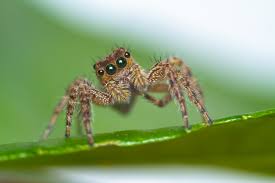
Jumping spiders are a fascinating group of spiders known for their agility and excellent vision. Their diet primarily consists of a variety of small arthropods, which they actively hunt. Jumping spiders are generalist predators and will consume a wide range of prey, including:
Insects: Jumping spiders commonly feed on insects such as flies, mosquitoes, moths, and ants. Their excellent vision and precise stalking abilities allow them to pounce on these small creatures with precision.
Other Spiders: They may also prey on other spiders, including web-building spiders. Jumping spiders can skillfully navigate through webs to capture the spider residing within.
Arachnids: In addition to insects, they may consume other arachnids like mites and small scorpions.
Small Invertebrates: Occasionally, they may feed on small invertebrates such as springtails or tiny beetles.
Jumping spiders use their silk to create shelters and safety lines for themselves but do not use it to capture prey like web-building spiders. Instead, they rely on their powerful vision, agility, and their ability to leap on their prey, using their silk as a safety line if they miss a jump. Their diet varies depending on their habitat and the availability of prey, and they play an essential role in controlling insect populations in various ecosystems.
General information on the subject of spring spider nutritionFirst of all, it is important to know that the right food for jumping spiders is exclusively different, living insects. One reason why jumping spiders are so special is the fact that they can catch food insects that are up to 1.5 times their size. The food insects are hunted on sight during the day and you can always observe their ability to jump when feeding the little ones. Bright lighting, enough warmth and a terrarium that is not too large are important for the animals to find their food and hunt successfully.
You can read more about this in the article on keeping jumping spiders. As a rule of thumb for a well-fed spider, its abdomen, i.e. its hindquarters, should not be larger than 1-1.5 times the size of its carapace, i.e. its “head”. If the abdomen of a spider is rather oval or elliptical, it could again tolerate food. If its abdomen appears plump and rather round, a feeding can be skipped without a guilty conscience. A slightly sunken, flat abdomen, on the other hand, is a sign of dehydration, so you should provide your spider with water again.

Jumping spiders are agile hunters and will be readily feeding on following feeder insects: Crickets, flies, roaches, meal worms, wax worms, moths etc. You will find a few good tips on what to feed your Jumping Spider below.
What Do Jumping Spiders Eat?
Jumping spiders have superior vision compared to most other spiders and combined with advance hunting tactics and intelligence hunters. In fact, Pridippus johnsoni also known as “Nefertiti” was sent to International space station in 2012 where it learned to catch flies in zero gravity and even came back to earth after that.You can learn more about that journey in fun book Nefertiti, the Spidernaut: The Jumping Spider Who Learned to Hunt in Space
Flies

Flies make an excellent feeder for a jumping spider that will provide the necessary nutrients and enrichment to a spider. These creatures are readily available in pet stores, online and fly larvae can be cheaply bought in most angler stores.
Drosophila melanogaster
Smallest flies available in trade are D.melanogaster and they are usually used to feed Phidippus hatchlings 1st-3rd instar. They cannot fly and can be easily contained when feeding time comes. They have relatively short life span but you can breed them in plastic tub setup once the initial culture is acquired.
Drosophila hydei
Next type of fly is D.hydei. They are very similar to D.melanogaster in care and ways they are breed, but are slightly bigger in size and you can offer to spiders 2nd-5th instar.
House flies / Green bottle fly / Bluebottle fly
Do not use the ones flying around your house as they can carry pests harmful to a spider. You can find any of them as larvae in angler stores or as a pupa (casters) online. Larvae will not need any food, just separate larva in small batches into several plastic tubs with ventilation and they can be stored in a fridge for weeks. Take them out and store in warm place to trigger pupation.
Once flies hatched they will need to be fed with sugar water or honey and can be stored in the fridge to prolong their life.
To avoid fly infestation in your house make sure plastic tubes do not have big enough holes for them to escape.
Before feeding jumping spiders with flies, put tub with flies in a fridge for few minutes to slow them down.
Crickets

Feeder insect that is available in most pet shops which you can easily purchase online will, of course, be crickets. You can get them at any size, starting with micro crickets which will be perfect for spiderlings and up to sub-adults when they best used for adult Phidippus.
Jumping spiders will actively react on offered cricket if hungry. However, if there is no reaction from a spider within a few minutes, you will need to take the cricket out of enclosure as it can be dangerous for moulting, old or just not hungry spiders. Sometimes when the cricket is left in the enclosure it can try biting the spider and can even kill it.
Same applies on locusts.
Mealworms
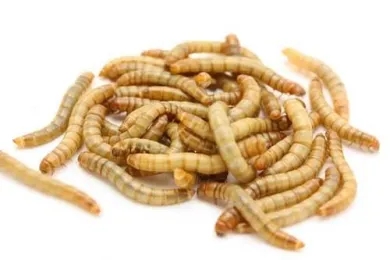
Mealworms are cheap and easy feeders you can easily keep alive for long or even sustainably breed. Their babies make a great snack for juvie Jumping spider and adult Jumping spiders generally can overpower adult mealworm. You can breed them in plastic tubs or drawers.
If you are using the enclosure with smooth walls (mealworms can’t climb smooth surfaces), couple mealworms can be dropped into an enclosure for a spider to eat as it pleases. However, offer them in moderation, they are high in fat and do not provide the best nutritional value on a long run but make an excellent addition to a varied diet.
Mealworms have strong jaws and can hurt jumping spider if are too large for a spider to cope with. Also, if mealworms stay in enclose for too long, they will mature into beetles and believe me, no one wants that in spider enclosure.
Waxworms

Waxworms are caterpillar larvae of waxworms and you can offer to a spider as larvae or as moths once it pupates and hatches. They are easily found in most pet stores and online and do not require a lot of care. You can store them in cooler temperatures for a few weeks. They are usually sold in round tubs with few waxworms and substrate that doubles up as food. Higher temperature will effect in faster pupation and hatch into moths.
Similar to Mealworm, waxworms are high in fat and must not be fed as a steady diet. Due to the size, you can only offer them to sub-adult spiders and adult jumping spiders.
You can also add a few mealworms to a spider enclosure and spider will eat them in all their development stages.
Jumping spiders will readily eat waxworms, moths that hatched and sometimes even pupa (spider version of burrito).
Roaches

I will be talking about 2 most commonly kept species of roaches, Dubia roaches and Turkistan / Red runner roaches, however, there is a huge variety of species available out there.
Roaches are considered one of the best feeders for arachnids. Not only that they are super easy to keep and breed and have long lifespan they offer great nutritional value for your pet spider. Roaches are less likely to hurt spider if left in an enclosure. However, they can disturb and stress spider that is going into moult.
You can offer baby roaches to Jumping spiders starting from 5th instar up. Just make sure though that the spider can overpower it.
As most of the other insect feeder described, you can buy these in pet stores, online and from private breeders.
Small colony or roaches can be easily kept in a plastic tube for years and it will grow in size quickly if you heat and feed appropriately.
How Do Jumping Spiders Eat?
Jumping spiders have a fascinating and unique way of feeding. Their feeding process can be broken down into several steps:
Hunting: Jumping spiders are active hunters. They use their excellent vision to locate potential prey. Their large, forward-facing eyes provide them with exceptional depth perception and color vision, helping them spot movement and recognize potential prey items.
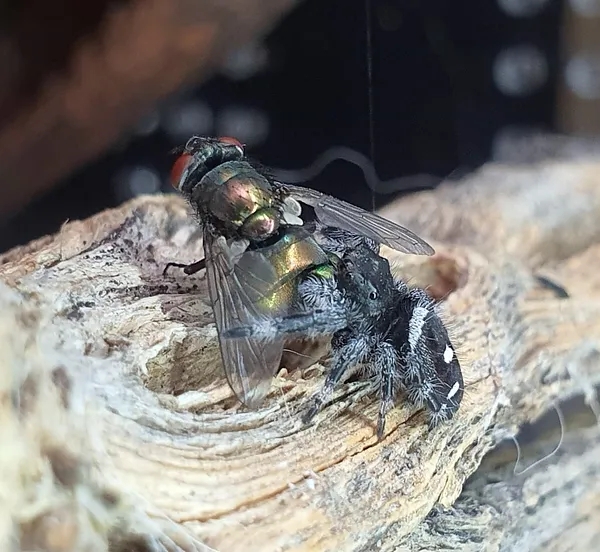
Stalking: Once a jumping spider identifies a target, it will slowly and stealthily approach its prey. They are known for their precise and cautious movements, which help them get as close as possible without being detected.
Pouncing: When the jumping spider is within striking distance, it will make a sudden, lightning-fast leap to capture its prey. This is where they get their name. They use a silk safety line to prevent themselves from falling if the jump doesn’t succeed.
Envenomation: As the spider lands on its prey, it delivers a paralyzing bite using its fangs (chelicerae). The venom injected into the prey’s body begins to immobilize and digest it.
Securing the Prey: After envenomation, the jumping spider may use additional silk to secure the prey, preventing it from escaping or falling. This silk can also be used to construct a temporary shelter or wrap the prey for later consumption.
Feeding: Jumping spiders are capable of both external and internal digestion. They secrete digestive enzymes that break down the prey’s soft tissues into a liquid, which the spider then sucks up through its straw-like mouthparts. This combination of external and internal digestion allows them to extract the maximum nutrients from their prey.
Regurgitation: If necessary, the spider may regurgitate digestive fluids onto the prey to further liquefy it and make the feeding process more efficient.
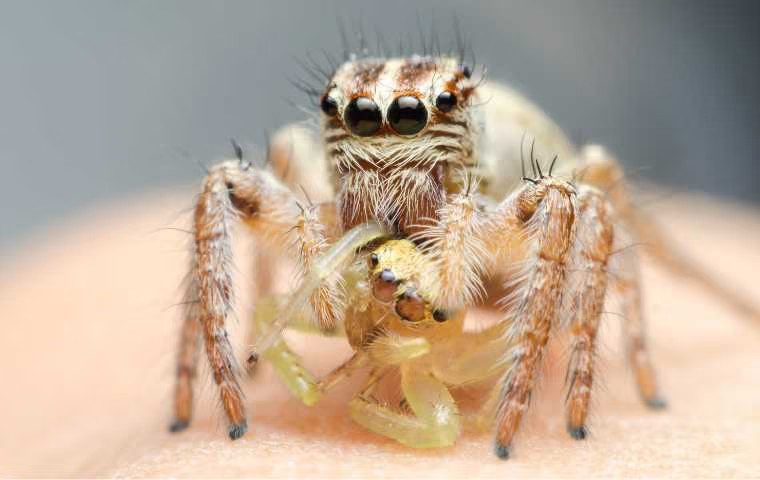
Jumping spiders are remarkably agile and precise hunters, and their feeding behavior is a testament to their unique adaptations for predation. Their small size and hunting strategy make them fascinating subjects for the study of arachnid behavior and biology.
How Often Do Jumping Spiders Eat?
Jumping spiders are known for their relatively high metabolic rates, and their feeding frequency can vary depending on several factors, including the individual spider’s size, age, and the availability of prey in their habitat. In general, jumping spiders tend to feed relatively frequently compared to some other spider species. Here are some factors that influence their feeding frequency:
Size and Life Stage: Smaller jumping spiders may need to eat more frequently than larger ones because of their higher metabolic rates. Juvenile jumping spiders, in particular, tend to eat more often as they grow rapidly.
Activity Level: Jumping spiders are active hunters and need to feed more often when they are actively hunting. An active adult jumping spider may hunt and eat daily or every few days.
Prey Availability: The availability of prey in their environment plays a crucial role. If there is an abundance of prey, jumping spiders may feed more frequently. Conversely, when prey is scarce, they may go without food for longer periods.
Season and Temperature: Jumping spider activity and feeding can be influenced by seasonal changes and temperature. They are more active during warmer months and may eat more frequently in such conditions.
Reproduction: Female jumping spiders may increase their feeding frequency when they are preparing to lay eggs and during egg development to provide energy for both themselves and their offspring.
Individual Variability: There can be considerable variability among different species of jumping spiders and even among individuals of the same species.
While some jumping spiders may feed daily, others may feed every few days or even less frequently, depending on their specific circumstances. Their ability to adjust their feeding frequency to match prey availability and their metabolic needs contributes to their adaptability and success as hunters.
Will Jumping Spiders Eat Dead Insects?
Jumping spiders are primarily active hunters and prefer live prey, but they can occasionally scavenge dead insects if the opportunity arises. However, scavenging is not their primary mode of feeding, and they are more efficient and effective hunters of live prey. Here are some key points to consider:
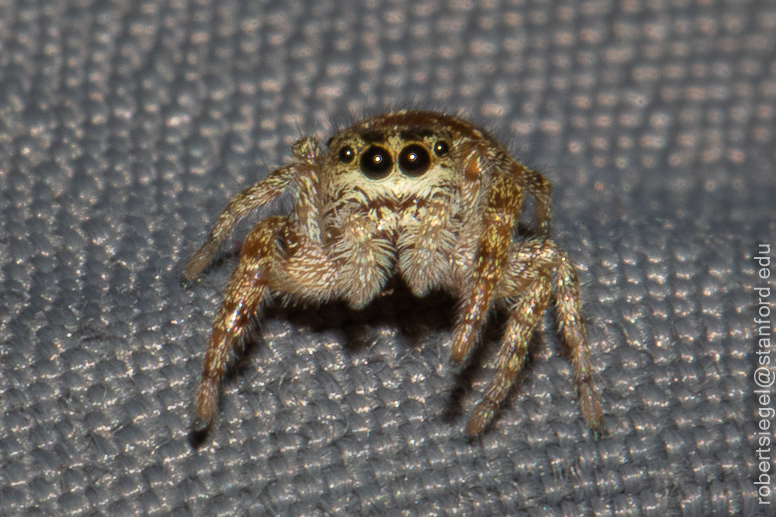
Preference for Live Prey: Jumping spiders have evolved to be agile and precise hunters. They rely on their excellent vision and hunting skills to capture live insects, which provides them with fresh and uncontaminated food.
Scavenging Behavior: While they are not specialized scavengers, jumping spiders may consume dead insects if they encounter them. This behavior is more likely in situations where live prey is scarce, and they are in need of food.
Potential Risks: Jumping spiders can be cautious and risk-averse. They may avoid consuming dead insects if there’s any suspicion of the prey being potentially harmful or carrying diseases.
Nutritional Value: Dead insects can be less nutritionally valuable than live ones because the enzymatic activity in dead insects starts breaking down their tissues, which can result in some loss of nutrients.
While jumping spiders primarily rely on live prey, they may opportunistically scavenge dead insects when necessary. However, their hunting and predation skills are better suited for capturing and consuming live prey, which provides them with a more reliable source of nutrition.
What to Feed your Jumping Spider
Updated: Jan 22What and when to feed your jumping spider can be one of the more confusing things about being a keeper. Why? Because ‘what and when’ relies heavily on the size of your spider, their moult stage, and their dinner.
What to Feed:
Fruit Flies
Two popular types are the smaller Drosophila Melanogaster which are perfect for hatchling spiders up to around 3rd instar, and the next size up Drosophila Hydei. These are great for juvenile spiders from 3rd to 6th instar. Your new jumping spider will most likely be eating the D.Hydei when they come to you as an 5th instar, but double check with your breeder and/or the spiders listing.
Both of these fruit flies have been specially bred to become flightless and are often sold as a culture. A culture is a pot where the circle of fruit fly life goes on inside to help keep you supplied with flies for longer, but it will start to dry up after about four weeks. After this time, there will be fewer flies that will be small and weak, and possibly have regained their ability to fly. Older cultures also have more chance of attracting grain mites. These mites are not harmful to your spider but can look unslightly and even get into your kitchen cupboards, yuck! The best practice is to keep the cultures on mite/fly paper and away from your spider (we don’t want a spider getting stuck on the sticky paper) and away from your kitchen. Have a look at my post on tips and tricks for feeding flies House Flies/Curly Wings
If you buy these, they will more than likely be named Curly Winged flies, bred with a deformity that stops them from flying so you can feed them easily. You buy them as casters which is the pupae stage of the fly life cycle, and you hatch them out to feed to your spood. The casters are kept in a fridge to slow down hatching, you place a few in a vented container at room temperature to hatch. I have a hard time hatching this type of fly as they are very delicate as pupae so when my spiders are ready to move on from fruit flies, I go straight onto Green Bottles or hatching Locust. Green Bottles and Bluebottles
Green bottles are slightly smaller than blue, but both are great prey for jumping spiders. They are often lousy flyers but still offer your spood a good hunting challenge. If one or two (7 or 8 in my case) escape, don’t panic; they often make their way to a window and are easily recaptured as they buzz about the glass.
You buy these as casters just like the Curly Wings, so pop some in a larger vented container with reptile jelly pots as food. You can find hatching kits in the online shop. Feeding them a jelly pot makes sure your hatched flies not only last longer but have a belly full of good stuff to pass on to your pet. The rest of the casters can be kept in the top or door of a fridge to slow down their hatching so you can have less waste. However, they will eventually hatch in your fridge Locust
These are a wonderful arboreal food for your spider and my favorite no-fuss feeder. Locusts are also something they would naturally come across up in the trees. They come in a variety of sizes and offer your little spood a different hunting challenge. What’s more, they can feast of leafy greens such as kale or cabbage to keep them healthy and then pass on that goodness to your spider. The larger locusts have strong, spiked back legs that can do damage. If they are particularly feisty you can snip the leg off before feeding. As long as the spider isn’t moulting they can potter about the enclosure till spider fancies a nibble. If after a day or two the spider still hasn’t eaten the locust, try a smaller size or be on the look out for other pre-moult signs. Hatchling locust are great for 5th and 6th instar spiders as an alternative to fruit flies. Small and medium sized locust are ideal for 7th instar up to adult, and particularly large adults are also able to eat a large locust. Like the fruit flies, the grains in the bottom of locust packing can have mites, so keep on sticky fly paper away from your spiders and kitchen. Black/Brown/Silent Crickets
These come in a range of sizes and love to feast on good foods like dark green veg, apple, and carrots, which is excellent for your spider. They are also a wildly available feeder with most petshops carrying the various sizes. The downside of these is that even if you hand feed, monitor, or take your spider out to feed, these little devils are wicked fast, they are expert hiders, and capable of biting back or even killing and eating a spider especially if they are moulting. For this reason I will always urge for a keeper to pick locusts instead, the risk is too high. Plus, don’t let the name fool you, they will eventually moult with the ability to chirp all night long which is particularly grating if one has escaped and chooses to sing the night away in your bedroom. These also have grain bases in their tubs so treat as other mite encourging prey with grain bases. Mealworms These make a tasty high, protein snack for your spider but are also rather fatty and should be feed sparingly or after a moult. If you crush their heads before serving them up, they can be safely given to your pet but the lack of wiggle may leave your spider looking at their dinner with confusion. An uncrushed mealworm is not only capable of giving your spider a nasty nip, but if they manage to bury into the substrate, you will end up with beetles. The beetles aren’t very nutritious and do have the capacity to bite but rarely do. It would be wise to err on the side of caution and make sure that the mealworms are either eaten or removed. Also has a mite encouraging grain base. Waxworms/Moths

Plump, tasty and full of fat. These are great treats, especially after a long moult, but you’ll need to go easy on them due to that high-fat content; no one wants a porky spood.
The moths can also be fed to your spider, but after their transformation from a waxworm, a lot of their nutrition has been used up.
I would advise against giving your spider anything you have caught from the wild. You don’t know what diseases or parasites they are carrying, what they have landed in, or if they have been sprayed with pest control before they bumped into you. If you need to dispose of any feeders it’s best to freeze them and then bin them. Many feeders are not from this country, and the ones that carry genetic deformities and should not be released into the wild just to be safe.
When:
Jumping spiders never know when they will catch their next meal in the wild. This makes them opportunistic hunters, so your spider will happily devour their meal and then move on to another if you give them half the chance. They won’t eat till they explode, but feeding too much or too often can cause their abdomen to become engorged; they will struggle to move around properly, which could lead to a fall, and worse, cause a fatal rupture from the fall, or catching on decor. Feeding too much too often has also been linked to causing them to moult sooner. There hasn’t been any research into if this technically shortens their lifespan, but with the other risks involved, it is best to watch what and when you feed very carefully.
Once they move on from fruit flies where they can be fed once a day, you will need to leave some days between feeds to ensure your spider remains a healthy size; this time between feeds is not an issue for them due to their natural metabolism. How many days depends on how big your pet is and how big their prey is. So if your little spider has a big mealworm, then 3 or 4 days would work. An older spider could be fed twice a week, on blue bottles, or have one big locust and be good for longer.
There is one way to help you gauge when to feed your spider: Their butt. Remember I said their abdomens become engorged? This is a sign your spider needs a few days without food. Over those days, continue to mist and keep an eye on their abdomen as it will decrease in size. Then you can offer food again.
Stuffed – Don’t offer food for a few days. Keep an eye on the abdomen until it shrink to normal and then feed again, especially if it is a prey that is bigger/longer than them. Normal – A tasty fly will be great about now, or maybe a small locust. Needs Food – A spider fresh out of moult may look like this, feel free to offer a larger fly or perhaps a chunky waxworm. If you have a mature female jumping spider, her bottom might not start shrinking as she could be carrying infertile eggs. In that case, a fly every two days will help her go through the cycle of building a nest, laying the eggs, staying with them and then eating them or abandoning them. If you have a mature male jumping spider, he may avoid food for what feels like too long. He is thinking of ladies and will eventually eat. Just keep offering and try not to worry too much.
